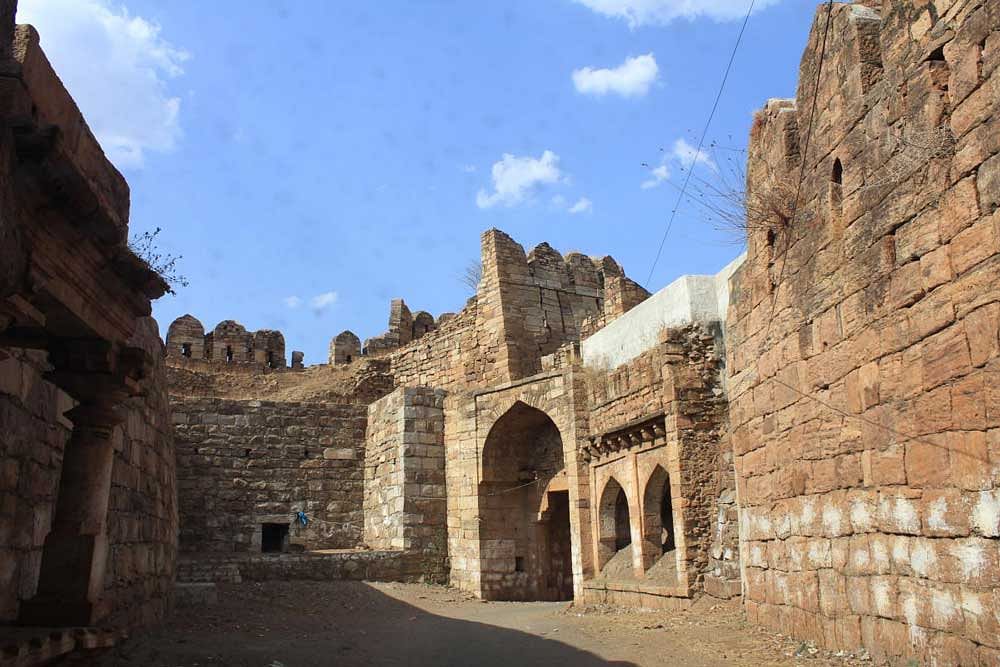As I sat with my friends to chalk out my itinerary for my bike expedition, I was bombarded with a thousand suggestions on what places should be included on my list of priorities. While pouring through maps and jotting down points on various tourist destinations, I decided to hitch upon the idea of visiting the forts of Karnataka. The list turned out be big and even among the numerous destinations, the lesser-known Torgal Fort in Ramdurg taluk of Belagavi district caught my attention. My curiosity got the better of me and I was soon on my bike, with my camera for company.
Around 10 km away from Ramdurg taluk, the drive, on a rugged terrain, took me uphill where the fort is located. Even as I negotiated the numerous sugarcane-filled tractors on the stretch, the whiff of fresh air laced with sugary fragrance was enough to infuse enthusiasm and eagerness. A few sugar factories have mushroomed up in the vicinity. None can miss the fort atop, which seems to beckon every passer-by.
Torgal Fort is not only majestic but also well planned and meticulously built with an eye for detail. The location and the terrain indicate that the fort was impregnable in the times of its glory. A huge moat of 20 feet deep and 15 feet wide encircles the fort. Built with yellow and red Shahabadi stones, the fort is surrounded by rocky hills on three sides. River Malaprabha flows silently on the other side and was a source of water to the moat that surrounds the structure. I looked around for local persons who could provide information about the fort. They happily obliged and gave me numerous accounts of the structure.
Many accounts
Stone inscriptions in Persian and Kannada languages installed outside the fort greet the visitors. These inscriptions date back to the 16th century. Torgal Fort was originally constructed with seven encircles or fortifications, of which only five remain in a sound state now. Hideouts can be found every 300 feet and watchtowers with minarets are present on all four sides of the fort. It is said that huge guns with stone balls were placed inside the fort and only two remain on display now. It is clear that not much effort has been made to preserve the fort and the structures it houses.
The locals enlightened me that Torgal Fort had four entrances, of which, only the entrance on the eastern side is presently in use. As I went further, I came across a few structures that are in ruins. A few stone slabs tempted me to rest on them for a while. I soaked myself into the eerie silence that was often interrupted by the gusty winds.
Deep into the interiors, I came across a structure with several carvings, which the locals too fumbled to decipher. Torgal Fort is spread over 100 acres and the rajawada or the palace is located in the centre and sprawls over five acres. I found various complexes that resembled different structures including a horse stable, court room, market place, armoury, warehouse etc.
It is believed that before the fort came up, a village woman called Mallamma, who was pregnant, attained samadhi for the prosperity of Torgal village. She is highly revered and a memorial has been constructed in her memory. The memorial is located on the northern side of the fort. The Bhootanatha Temple, which depicts Chalukya style of architecture, and a mosque can also be seen inside the fort complex.
The rulers
While reading a few references from history, I could gather that nine generations of Shindhe kings ruled the region. The last among them was Narasojirao Shindhe, who ruled Torgal jahagir between 1932 and 1949. In 1949, the kingdom was merged into the Republic of India. As a mark of respect, people from
Torgal and the surrounding villages address Sanjay Singh, the descendant of the royal family, as their maharaja. The Shindhe family continues to reside in the wade, located near the palace. In 1100 AD,
King Bhootashaya is said to have developed
Torgal village and the fort. When Chhatrapati Shivaji Maharaj decided to expand his kingdom, he is said to have sent 12 battalions under the able guidance of his trusted soldiers, Appaji Suro and Malaji Meerasaheb Bhonsle, to capture the southern regions. These soldiers camped at Torgal Fort and converted it as their central point for kingdom expansion.
Narasoji Shindhe, who was a mandalik (chieftain) under the Adil Shahis of Bijapur and later with the Chhatrapati of Kolhapur, founded the Torgal province in 1690. Narasoji was also honoured with the title, Sena Khas Khel. Jeejabai, daughter of Narasoji, was married to Sambhaji, the prince of Kolhapur. As a result of these connections, Torgal province was an important province in those days. Records state that once upon a time, Torgal boasted of a huge population, while today, hardly a thousand reside here presently.
(Translated by Jyotsna P Dharwad)
